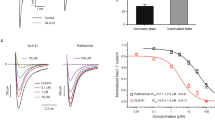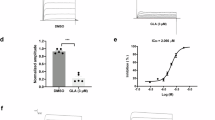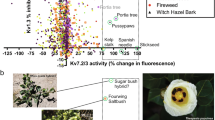Abstract
The activation of voltage-gated potassium Kv7/M channels is an attractive therapeutic strategy for chronic pain. Galangin, the principal active component of the medicinal herb Alpinia officinarum Hance, has exhibited analgesic effects in mice. In this study, we investigated the antinociceptive effects of galangin in the treatment of various types of chronic pain and the underlying mechanisms. Using whole-cell recordings of CHO cells expressing Kv7.2/Kv7.3 channels, we showed that galangin enhanced Kv7.2/Kv7.3 currents in a concentration-dependent manner, with an EC50 value of 8.8 ± 1.6 μM, and shifted the voltage-dependent activation curve of the channels toward depolarization. We demonstrated that galangin selectively and potently activated the Kv7.2, Kv7.4, and Kv7.5 channels while reducing the Kv7.1 current and exerting no effect on the Kv7.3 current. Notably, galangin no longer increased the current amplitude and slightly shifted the voltage-dependent activation of the Kv7.2 (E322A) mutant, suggesting that Glu-322 in Kv7.2 is important for galangin activation of the channels. Moreover, we showed that galangin (100 μM) significantly enhanced the M-current and consequently reduced the excitability of DRG neurons in SNI mice. In multiple chronic pain mouse models, the administration of galangin (15 mg/kg, i.p.) significantly increased the threshold for mechanical stimuli and the withdrawal latency to thermal stimuli, which were reversed by the Kv7/M channel blocker XE991. Taken together, the results of this study demonstrated that galangin exerts its antinociceptive effects mainly through the activation of Kv7/M channels, representing a novel approach for treating neuronal excitatory diseases.

This is a preview of subscription content, access via your institution
Access options
Subscribe to this journal
Receive 12 print issues and online access
$259.00 per year
only $21.58 per issue
Buy this article
- Purchase on SpringerLink
- Instant access to full article PDF
Prices may be subject to local taxes which are calculated during checkout







Similar content being viewed by others
References
Cohen SP, Vase L, Hooten WM. Chronic pain: an update on burden, best practices, and new advances. Lancet. 2021;397:2082–97.
Mills SEE, Nicolson KP, Smith BH. Chronic pain: a review of its epidemiology and associated factors in population-based studies. Br J Anaesth. 2019;123:E273–E283.
Barker BS, Spampanato J, Mccarren HS, Berger K, Jackson CE, Yeung DT, et al. The K(v)7 modulator, retigabine, is an efficacious antiseizure drug for delayed treatment of organophosphate-induced status epilepticus. Neuroscience. 2021;463:143–58.
Mercadante S. Prospects and challenges in opioid analgesia for pain management. Curr Med Res Opin. 2011;27:1741–3.
Power I. An update on analgesics. Br J Anaesth. 2011;107:19–24.
Fillingim RB, Loeser JD, Baron R, Edwards RR. Assessment of chronic pain: domains, methods, and mechanisms. J Pain. 2016;17:T10–T20.
Wladyka CL, Kunze DL. KCNQ/M-currents contribute to the resting membrane potential in rat visceral sensory neurons. J Physiol-Lond. 2006;575:175–89.
Peng H, Bian XL, Ma FC, Wang KW. Pharmacological modulation of the voltage-gated neuronal Kv7/KCNQ/M-channel alters the intrinsic excitability and synaptic responses of pyramidal neurons in rat prefrontal cortex slices. Acta Pharmacol Sin. 2017;38:1248–56.
Schwake M, Athanasiadu D, Beimgraben C, Blanz J, Beck C, Jentsch TJ, et al. Structural determinants of M-type KCNQ (Kv7) K+ channel assembly. J Neurosci. 2006;26:3757–66.
Peters HC, Hu H, Pongs O, Storm JF, Isbrandt D. Conditional transgenic suppression of M channels in mouse brain reveals functions in neuronal excitability, resonance and behavior. Nat Neurosci. 2005;8:51–60.
Jentsch TJ. Neuronal KCNQ potassium channels: physiology and role in disease. Nat Rev Neurosci. 2000;1:21–30.
Zhan D, Zhang J, Su S, Ren X, Zhao S, Zang W, et al. TET1 participates in complete Freund’s adjuvant-induced trigeminal inflammatory pain by regulating Kv7.2 in a mouse model. Neurosci Bull. 2024;40:707–18.
Berta T, Strong JA, Zhang JM, Ji RR. Targeting dorsal root ganglia and primary sensory neurons for the treatment of chronic pain: an update. Expert Opin Ther Tar. 2023;27:665–78.
Smith PAK. Channels in primary afferents and their role in nerve injury-induced pain. Front Cell Neurosci. 2020;14:566418.
Esposito MF, Malayil R, Hanes M, Deer T. Unique characteristics of the dorsal root ganglion as a target for neuromodulation. Pain Med. 2019;20:S23–30.
Tatulian L, Delmas P, Abogadie FC, Brown DA. Activation of expressed KCNQ potassium currents and native neuronal M-type potassium currents by the anti-convulsant drug retigabine. J Neurosci. 2001;21:5535–45.
Klinger F, Geier P, Dorostkar MM, Chandaka GK, Yousuf A, Salzer I, et al. Concomitant facilitation of GABAA receptors and KV7 channels by the non-opioid analgesic flupirtine. Br J Pharmacol. 2012;166:1631–42.
Deeks ED. Retigabine (ezogabine): in partial-onset seizures in adults with epilepsy. CNS Drugs. 2011;25:887–900.
Garin Shkolnik T, Feuerman H, Didkovsky E, Kaplan I, Bergman R, Pavlovsky L, et al. Blue-gray mucocutaneous discoloration: a new adverse effect of ezogabine. JAMA Dermatol. 2014;150:984–9.
Djouhri L, Malki MI, Zeidan A, Nagi K, Smith T. Activation of K7 channels with the anticonvulsant retigabine alleviates neuropathic pain behaviour in the streptozotocin rat model of diabetic neuropathy. J Drug Target. 2019;27:1118–26.
Cai J, Fang D, Liu XD, Li S, Ren J, Xing GG. Suppression of KCNQ/M (Kv7) potassium channels in the spinal cord contributes to the sensitization of dorsal horn WDR neurons and pain hypersensitivity in a rat model of bone cancer pain. Oncol Rep. 2015;33:1540–50.
Hayashi H, Iwata M, Tsuchimori N, Matsumoto T. Activation of peripheral KCNQ channels attenuates inflammatory pain. Mol Pain. 2014;10:15.
Hirano K, Kuratani K, Fujiyoshi M, Tashiro N, Hayashi E, Kinoshita M. Kv7.2-7.5 voltage-gated potassium channel (KCNQ2-5) opener, retigabine, reduces capsaicin-induced visceral pain in mice. Neurosci Lett. 2007;413:159–62.
Li H, Wang F, Wang X, Sun R, Chen J, Chen B, et al. Antinociceptive efficacy of retigabine in the monosodium lodoacetate rat model for osteoarthritis pain. Pharmacology. 2015;95:251–7.14.
Goodchild CS, Nelson J, Cooke I, Ashby M, Jackson K. Combination therapy with flupirtine and opioid: open-label case series in the treatment of neuropathic pain associated with cancer. Pain Med. 2008;9:939–49.
Szelenyi I. Flupirtine, a re-discovered drug, revisited. Inflamm Res. 2013;62:251–8.
Gribkoff VK. The therapeutic potential of neuronal KCNQ channel modulators. Expert Opin Ther Targets. 2003;7:737–48.
Wulff H, Castle NA, Pardo LA. Voltage-gated potassium channels as therapeutic targets. Nat Rev Drug Discov. 2009;8:982–1001.
Abubakar IB, Malami I, Yahaya Y, Sule SM. A review on the ethnomedicinal uses, phytochemistry and pharmacology of Alpinia officinarum Hance. J Ethnopharmacol. 2018;224:45–62.
Zhang X, Xie Z, Chen X, Qiu J, Tan Y, Li X, et al. Herb-drug interaction in the protective effect of Alpinia officinarum against gastric injury induced by indomethacin based on pharmacokinetic, tissue distribution and excretion studies in rats. J Pharm Anal. 2021;11:200–9.
Gong J, Zhang Z, Zhang X, Chen F, Tan Y, Li H, et al. Effects and possible mechanisms of Alpinia officinarum ethanol extract on indomethacin-induced gastric injury in rats. Pharm Biol. 2018;56:294–301.
Lin K, Wang Z, Wang E, Zhang X, Liu X, Feng F, et al. Targeting TRPV1 signaling: Galangin improves ethanol-induced gastric mucosal injury. J Ethnopharmacol. 2024;335:118605.
Lin K, Wang Y, Gong J, Tan Y, Deng T, Wei N. Protective effects of total flavonoids from Alpinia officinarum rhizoma against ethanol-induced gastric ulcer in vivo and in vitro. Pharm Biol. 2020;58:854–62.
Lei X, Wang J, Zuo K, Xia T, Zhang J, Xu X, et al. Alpinia officinarum Hance: a comprehensive review of traditional uses, phytochemistry, pharmacokinetic and pharmacology. Front Pharmacol. 2024;15:1414635.
Liu D, Qu W, Zhao L, Guan FQ, Liang JY. A new dimeric diarylheptanoid from the rhizomes of Alpinia officinarum. Chin J Nat Med. 2014;12:139–41.
Lee J, Kim KA, Jeong S, Lee S, Park HJ, Kim NJ, et al. Anti-inflammatory, anti-nociceptive, and anti-psychiatric effects by the rhizomes of Alpinia officinarum on complete Freund’s adjuvant-induced arthritis in rats. J Ethnopharmacol. 2009;126:258–64.
Honmore VS, Kandhare AD, Kadam PP, Khedkar VM, Sarkar D, Bodhankar SL, et al. Isolates of Alpinia officinarum Hance as COX-2 inhibitors: evidence from anti-inflammatory, antioxidant and molecular docking studies. Int Immunopharmacol. 2016;33:8–17.
Zhu L, Luo Q, Bi J, Ding J, Ge S, Chen F. Galangin inhibits growth of human head and neck squamous carcinoma cells in vitro and in vivo. Chem Biol Interact. 2014;224:149–56.
Zhong Y, Li MY, Han L, Tai Y, Cao S, Li J, et al. Galangin inhibits programmed cell death-ligand 1 expression by suppressing STAT3 and MYC and enhances T cell tumor-killing activity. Phytomedicine. 2023;116:154877.
Ouyang J, Sun F, Feng W, Xie Y, Ren L, Chen Y. Antimicrobial activity of galangin and its effects on murein hydrolases of vancomycin-intermediate Staphylococcus aureus (VISA) Strain Mu50. Chemotherapy. 2018;63:20–28.
Fu J, Wang Y, Sun M, Xu Y, Chen L. Antibacterial activity and components of the methanol-phase extract from rhizomes of pharmacophagous plant Alpinia officinarum Hance. Molecules. 2022;27:4308.
Khawaja G, El-Orfali Y, Shoujaa A, Abou Najem S. Galangin: a promising flavonoid for the treatment of rheumatoid arthritis-mechanisms, evidence, and therapeutic potential. Pharmaceuticals. 2024;17:963.
Thapa R, Afzal O, Altamimi ASA, Goyal A, Almalki WH, Alzarea SI, et al. Galangin as an inflammatory response modulator: An updated overview and therapeutic potential. Chem Biol Interact. 2023;378:110482.
Tolomeo M, Grimaudo S, Di Cristina A, Pipitone RM, Dusonchet L, Meli M, et al. Galangin increases the cytotoxic activity of imatinib mesylate in imatinib-sensitive and imatinib-resistant Bcr-Abl expressing leukemia cells. Cancer Lett. 2008;265:289–97.
Ha TK, Kim ME, Yoon JH, Bae SJ, Yeom J, Lee JS. Galangin induces human colon cancer cell death via the mitochondrial dysfunction and caspase-dependent pathway. Exp Biol Med. 2013;238:1047–54.
Lu YH, Lin-Tao, Wang ZT, Wei DZ, Xiang HB. Mechanism and inhibitory effect of galangin and its flavonoid mixture from on mushroom tyrosinase and B16 murine melanoma cells. J Enzym Inhib Med Ch. 2007;22:433–8.
Zhang F, Yan Y, Zhang LM, Li DX, Li L, Lian WW, et al. Pharmacological activities and therapeutic potential of galangin, a promising natural flavone, in age-related diseases. Phytomedicine. 2023;120:155061.
Hewage SRKM, Piao MJ, Kim KC, Cha JW, Han X, Choi YH, et al. Galangin (3,5,7-trihydroxyflavone) shields human keratinocytes from ultraviolet B-induced oxidative stress. Biomol Ther. 2015;23:165–73.
Kong J, Li MY, Li YT, Liu M, Zhang Q, Liu J, et al. Effect of the bile salt surfactant sodium taurodeoxycholate on the physicochemical properties of a mixed system of Galangin-Hemoglobin and Baicalein-Hemoglobin. J Mol Liq. 2023;391(Part A):123302.
Lin KW, Fu DT, Wang ZT, Zhang XE, Zhu CY. Analgesic and anti-inflammatory effects of galangin: a potential pathway to inhibit transient receptor potential vanilloid 1 receptor activation. Korean J Pain. 2024;37:151–63.
Su Y, Shen LX, Xue JF, Zou J, Wan DQ, Shi ZM. Therapeutic evaluation of galangin on cartilage protection and analgesic activity in a rat model of osteoarthritis. Electron J Biotechnol. 2021;53:8–13.
Kilkenny C, Browne WJ, Cuthill IC, Emerson M, Altman DG. Improving bioscience research reporting: the ARRIVE guidelines for reporting animal research. PLoS Biol. 2010;8:e1000412.
Zhang F, Liu Y, Tang F, Liang B, Chen H, Zhang H, et al. Electrophysiological and pharmacological characterization of a novel and potent neuronal Kv7 channel opener SCR2682 for antiepilepsy. FASEB J. 2019;33:9154–66.
Isabelle D. Spared nerve injury: an animal model of persistent peripheral neuropathic pain. Pain. 2000;87:149–58.
Jiang SS, Li ZYQ, Huang SJ, Zou WY, Luo JG. IRF7 overexpression alleviates CFA-induced inflammatory pain by inhibiting nuclear factor-κB activation and pro-inflammatory cytokines expression in rats. Brain Behav Immun. 2024;120:10–20.
Bonnet CS, Gilbert SJ, Williams AS, Walsh DA, Mason DJ. NBQX, an AMPA-kainate glutamate receptor antagonist, alleviates inflammation and pain related behaviour in two models of osteoarthritis. Int J Exp Pathol. 2016;97:A17–A18.
Zhang F, Mi Y, Qi JL, Li JW, Si M, Guan BC, et al. Modulation of K(v)7 potassium channels by a novel opener pyrazolo[1,5-a]pyrimidin-7(4H)-one compound QO-58. Br J Pharmacol. 2013;168:1030–42.
Brickel N, Gandhi P, Vanlandingham K, Hammond J, Derossett S. The urinary safety profile and secondary renal effects of retigabine (ezogabine): A first-in-class antiepileptic drug that targets KCNQ (Kv7) potassium channels. Epilepsia. 2012;53:606–12.
Wuttke TV, Seebohm G, Bail S, Maljevic S, Lerche H. The new anticonvulsant retigabine favors voltage-dependent opening of the KV7.2 channel by binding to its activation gate. Mol Pharmacol. 2005;67:1009–17.
Zhang D, Thimmapaya R, Zhang XF, Anderson DJ, Baranowski JL, Scanio M, et al. KCNQ2/3 openers show differential selectivity and site of action across multiple KCNQ channels. J Neurosci Methods. 2011;200:54–62.
Li X, Zhang Q, Guo P, Fu J, Mei L, Lv D, et al. Molecular basis for ligand activation of the human KCNQ2 channel. Cell Res. 2021;31:52–61.
Beyak MJ, Vanner S. Inflammation-induced hyperexcitability of nociceptive gastrointestinal DRG neurones: the role of voltage-gated ion channels. Neurogastroenterol Motil. 2005;17:175–86.
Podgorski Iii E, Mascaro P, Patin D. Comparison of FDA-approved electrical neuromodulation techniques for focal neuropathic pain: a narrative review of DRG, HF10, and burst neuromodulation. Pain Physician. 2021;24:E407–E423.
Rose K, Ooi L, Dalle C, Robertson B, Wood IC, Gamper N. Transcriptional repression of the M channel subunit Kv7.2 in chronic nerve injury. Pain. 2011;152:742–54.
Zheng Q, et al. Suppression of KCNQ/M (Kv7) potassium channels in dorsal root ganglion neurons contributes to the development of bone cancer pain in a rat model. Pain. 2013;154:434–48.
Alhassen L, Alhassen W, Wong C, Sun Y, Xia Z, Civelli O, et al. Dehydroepiandrosterone sulfate (DHEAS) is an endogenous Kv7 channel modulator that reduces Kv7/M-current suppression and inflammatory pain. J Neurosci. 2023;43:7073–83.
Liu Y, Bian X, Wang K. Pharmacological activation of neuronal voltage-gated Kv7/KCNQ/M-channels for potential therapy of epilepsy and pain. Handb Exp Pharmacol. 2021;267:231–51.
Shah M, Mistry M, Marsh SJ, Brown DA, Delmas P. Molecular correlates of the M-current in cultured rat hippocampal neurons. J Physiol. 2002;544:29–37.
Passmore GM, Selyanko AA, Mistry M, Al-Qatari M, Marsh SJ, Matthews EA, et al. KCNQ/M currents in sensory neurons: significance for pain therapy. J Neurosci. 2003;23:7227–36.
Xiao Y, Wu Y, Zhao B, Xia Z. Decreased voltage-gated potassium currents in rat dorsal root ganglion neurons after chronic constriction injury. Neuroreport. 2016;27:104–9.
Du XN, Zhang X, Qi JL, An HL, Li JW, Wan YM, et al. Characteristics and molecular basis of celecoxib modulation on KV7 potassium channels. Br J Pharmacol. 2011;164:1722–37.
Gao Z, Zhang T, Wu M, Xiong Q, Sun H, Zhang Y, et al. Isoform-specific prolongation of Kv7 (KCNQ) potassium channel opening mediated by new molecular determinants for drug-channel interactions. J Biol Chem. 2010;285:28322–32.
Ballantyne JC, Sullivan MD, Koob GF. Refractory dependence on opioid analgesics. Pain. 2019;160:2655–60.
Davis MP. Opioid receptor targeting ligands for pain management: a review and update. Expert Opin Drug Discov. 2010;5:1007–22.
Teng BC, Song Y, Zhang F, Ma TY, Qi JL, Zhang HL, et al. Activation of neuronal Kv7/KCNQ/M-channels by the opener QO58-lysine and its anti-nociceptive effects on inflammatory pain in rodents. Acta Pharmacol Sin. 2016;37:1054–62.
Devulder J. Flupirtine in pain management pharmacological properties and clinical use. CNS Drugs. 2010;24:867–81.
Acknowledgements
This work was supported by STI 2030-Major Projects [Grant 2021ZD 0203200-04, China] (to FZ), the National Natural Science Foundation of China [Grant 32171018 and 32471066, China] (to FZ), the Natural Science Foundation of Hebei Province [Grant H2022206011 and C2024206032, China] (to FZ), and the Top Talent of Young People of Hebei Province (to FZ).
Author information
Authors and Affiliations
Contributions
BY and Hui L conducted the pharmacological experiments, analyzed the data and wrote the paper. WJZ, JRM, ZSK and YJZ were involved in the animal experiments. YLG, XKL and ZWM analyzed the data. RFC and YLW edited and proofread the drafts and the final version of the article. FZ and Han L conceived/supervised the projects, designed the experiments, and revised the article.
Corresponding authors
Ethics declarations
Competing interests
The authors declare no competing interests.
Additional information
Publisher’s note Springer Nature remains neutral with regard to jurisdictional claims in published maps and institutional affiliations.
Rights and permissions
Springer Nature or its licensor (e.g. a society or other partner) holds exclusive rights to this article under a publishing agreement with the author(s) or other rightsholder(s); author self-archiving of the accepted manuscript version of this article is solely governed by the terms of such publishing agreement and applicable law.
About this article
Cite this article
Yang, B., Liu, H., Zhao, Wj. et al. Galangin, a novel Kv7 potassium channel opener, exerts potent antinociceptive effects in multiple chronic pain mouse models. Acta Pharmacol Sin (2025). https://doi.org/10.1038/s41401-025-01627-2
Received:
Accepted:
Published:
DOI: https://doi.org/10.1038/s41401-025-01627-2



